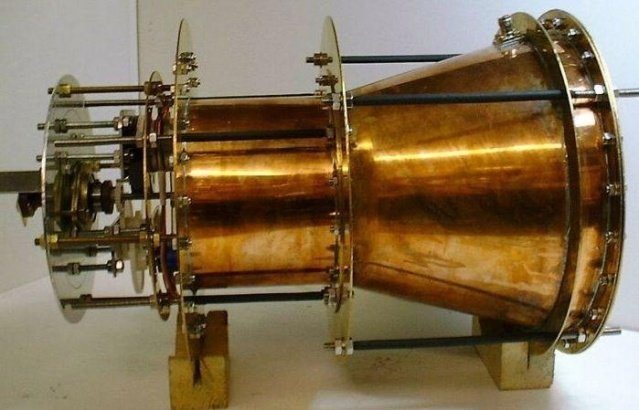NASA Confirms its “Impossible” EmDrive Thruster Works
Ashley Allen / 9 years ago

NASA’s EMdrive – a fuelless electromagnetic propulsion system capable of pushing spacecraft to astronomical speeds once erroneously dubbed a real-world “warp drive” – has been branded “impossible” by the laws of physics, but the astronautics agency has confirmed during a second round of tests that, yes, it works. Scotty be damned.
https://youtu.be/nfZ12UGiisM?t=22s
Rewriting the fundamental principles of physics as we know them, the EmDrive, developed by NASA engineer Roger Shawyer, uses magnetron and microwaves to propel a spacecraft at speeds previously considered more appropriate to science fiction than reality. The microwaves are forced through a cone, through which it builds momentum as it loops back to push a vessel forward. The key here is that the action does not have an equal and opposite reaction, violating Newton’s Third Law.
Paul March, an engineer for NASA’s EagleWorks Labs, posted the following on NASA’s spaceflight forum:
“All:
I wish I could show you all the pictures I’ve taken on how we saluted and mitigated the issues raised by our EW Lab’s Blue-Ribbon PhD panel and now Potomac-Neuron’s paper, on the possible Lorentz force interactions. That being the Lorentz Interactions with the dc currents on the EW torque pendulum (TP) with the stray magnetic fields from the torque pendulum’s first generation open-face magnetic damper and the Earth’s geomagnetic field, but I can’t due to the restrictive NASA press release rules now applied to the EW Lab.
However since I still can’t show you this supporting data until the EW Lab gets our next peer-reviewed lab paper published, I will tell you that we first built and installed a 2nd generation, closed face magnetic damper that reduced the stray magnetic fields in the vacuum chamber by at least an order of magnitude and any Lorentz force interactions it could produce. I also changed up the torque pendulum’s grounding wire scheme and single point ground location to minimize ground loop current interactions with the remaining stray magnetic fields and unbalanced dc currents from the RF amplifier when its turned on. This reduced the Lorentz force interaction to less than 2 micro-Newton (uN) for the dummy load test. Finally we rebuilt the copper frustum test article so that it is now fully integrated with the RF VCO, PLL, 100W RF amp, dual directional coupler, 3-stub tuner and connecting coax cables, then mounted this integrated test article at the opposite end of the torque pendulum, as far away as possible from the 2nd generation magnetic damper where only the required counterbalance weights now reside. Current null testing with both the 50 ohm dummy load and with the integrated test article rotated 90 degrees with respect to the TP sensitive axis now show less than one uN of Lorentz forces on the TP due to dc magnetic interactions with the local environment even when drawing the maximum RF amp dc current of 12 amps.
Given all of the above TP wiring and test article modifications with respect to our 2014 AIAA/JPC paper design baseline needed to address these Lorentz force magnetic interaction issues, we are still seeing over 100uN of force with 80W of RF power going into the frustum running in the TM212 resonant mode, now in both directions, dependent on the direction of the mounted integrated test article on the TP. However these new plus and minus thrust signatures are still contaminated by thermally induced TP center of gravity (cg) zero-thrust baseline shifts brought on by the expansion of the copper frustum and aluminum RF amp and its heat sink when heated by the RF, even though these copper and aluminum cg shifts are now fighting each other. (Sadly these TP cg baseline shifts are ~3X larger in-vacuum than in-air due to the better insulating qualities of the vacuum, so the in-vacuum thrust runs look very thermally contaminated whereas the in-air run look very impulsive.) So we have now developed an analytical tool to help separate the EM-Drive thrust pulse waveform contributions from the thermal expansion cg induced baseline shifts of the TP. Not being satisfied with just this analytical impulsive vs thermal signal separation approach, we are now working on a new integrated test article subsystem mounting arrangement with a new phase-change thermal management subsystem that should mitigate this thermally induced TP cg baseline shift problem once and for-all.
And yet the anomalous thrust signals remain…
Best, Paul March”
Tl;dr: it works!
While still in its infancy, and with the effects on humans of travelling at such speeds is yet to be determined, the EMdrive marks potentially the greatest single astronautics advancement since the rocket engine.
Image courtesy of Spaceflight Insider.



















